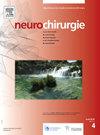Primary central nervous system lymphoma: A 7 years single-center experience
IF 1.4
4区 医学
Q4 CLINICAL NEUROLOGY
引用次数: 0
Abstract
Background and objectives
Primary central nervous system lymphoma (PCNSL) is a rare hematological malignancy, affecting the central nervous system (CNS), meninges, or eyes. Advancements in treatment, particularly with IV high-dose methotrexate, have improved patient survival. Diagnosis is primarily based on contrast-enhanced brain MRI, followed by confirmation through brain biopsy. However, biological markers such as cerebrospinal fluid (CSF) or vitreous humor lymphocyte immunophenotyping and interleukin levels (IL-6 and IL-10) can aid diagnosis, especially in cases where biopsy is difficult.
Methods
This retrospective observational study examines the diagnostic features of PCNSL patients at CHRU de Tours from 2017 to 2023. It focuses on MRI feature, ophthalmological examination, brain biopsy results and biomarker findings in CSF and vitreous humor.
Results
65 adult patients with a confirmed PCNSL were included. Brain biopsy, performed in 34 cases (52%), remained the gold standard. Cytological confirmation, including immunophenotyping, was decisive in 17% of cases with vitreous samples and 14% with cerebrospinal fluid (CSF) samples. Elevated interleukin levels alone guided treatment in 6% of patients with vitreous samples and 5% with CSF samples. Lastly, 6% of patients, without definitive biological markers, were treated based on clinical presentation and characteristic MRI features after ruling out major differential diagnoses.
Conclusions
PCNSL diagnosis can be achieved through various methods. Indirect biological markers like interleukin 6 and 10, while helpful, remain supplementary diagnostic tools. A standardized diagnostic protocol could enhance rapid diagnosis and timely treatment, which is crucial for improving therapeutic outcomes.
原发性中枢神经系统淋巴瘤:7年的单中心经验:标题:原发性中枢神经系统淋巴瘤:诊断工具。
背景和目的:原发性中枢神经系统淋巴瘤(PCNSL)是一种罕见的血液系统恶性肿瘤,影响中枢神经系统(CNS)、脑膜或眼睛。治疗的进步,特别是静脉注射大剂量甲氨蝶呤,提高了患者的生存率。诊断主要基于对比增强脑MRI,然后通过脑活检确认。然而,生物标志物,如脑脊液(CSF)或玻璃体淋巴细胞免疫表型和白细胞介素水平(IL-6和IL-10)可以帮助诊断,特别是在活检困难的情况下。方法:本回顾性观察研究分析了2017年至2023年在图尔CHRU的PCNSL患者的诊断特征。它侧重于MRI特征,眼科检查,脑活检结果和脑脊液和玻璃体的生物标志物发现。结果:纳入了65例确诊的PCNSL成年患者。34例(52%)患者进行了脑活检,仍然是金标准。细胞学确认,包括免疫表型,对玻璃体样本的17%和脑脊液(CSF)样本的14%具有决定性作用。在玻璃体样本和脑脊液样本中,分别有6%和5%的患者仅以白细胞介素水平升高为治疗指导。最后,6%没有明确生物标志物的患者在排除主要鉴别诊断后,根据临床表现和特征性MRI特征进行治疗。结论:PCNSL的诊断方法多种多样。间接的生物标志物,如白细胞介素6和10,虽然有帮助,但仍然是辅助诊断工具。标准化的诊断方案可以提高快速诊断和及时治疗,这对改善治疗效果至关重要。
本文章由计算机程序翻译,如有差异,请以英文原文为准。
求助全文
约1分钟内获得全文
求助全文
来源期刊

Neurochirurgie
医学-临床神经学
CiteScore
2.70
自引率
6.20%
发文量
100
审稿时长
29 days
期刊介绍:
Neurochirurgie publishes articles on treatment, teaching and research, neurosurgery training and the professional aspects of our discipline, and also the history and progress of neurosurgery. It focuses on pathologies of the head, spine and central and peripheral nervous systems and their vascularization. All aspects of the specialty are dealt with: trauma, tumor, degenerative disease, infection, vascular pathology, and radiosurgery, and pediatrics. Transversal studies are also welcome: neuroanatomy, neurophysiology, neurology, neuropediatrics, psychiatry, neuropsychology, physical medicine and neurologic rehabilitation, neuro-anesthesia, neurologic intensive care, neuroradiology, functional exploration, neuropathology, neuro-ophthalmology, otoneurology, maxillofacial surgery, neuro-endocrinology and spine surgery. Technical and methodological aspects are also taken onboard: diagnostic and therapeutic techniques, methods for assessing results, epidemiology, surgical, interventional and radiological techniques, simulations and pathophysiological hypotheses, and educational tools. The editorial board may refuse submissions that fail to meet the journal''s aims and scope; such studies will not be peer-reviewed, and the editor in chief will promptly inform the corresponding author, so as not to delay submission to a more suitable journal.
With a view to attracting an international audience of both readers and writers, Neurochirurgie especially welcomes articles in English, and gives priority to original studies. Other kinds of article - reviews, case reports, technical notes and meta-analyses - are equally published.
Every year, a special edition is dedicated to the topic selected by the French Society of Neurosurgery for its annual report.
 求助内容:
求助内容: 应助结果提醒方式:
应助结果提醒方式:


